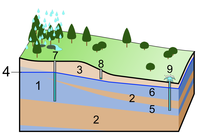
Photo from wikipedia
In this work, we utilize two cascade coupling modes (unidirectional coupling and bidirectional coupling) to construct a four-layer deep reservoir computing (RC) system based on the cascade coupled optically-pumped spin-VCSEL.… Click to show full abstract
In this work, we utilize two cascade coupling modes (unidirectional coupling and bidirectional coupling) to construct a four-layer deep reservoir computing (RC) system based on the cascade coupled optically-pumped spin-VCSEL. In such a system, there are double sub-reservoirs in each layer, which are formed by the chaotic x-PC and y-PC emitted by the reservoir spin-VCSEL in each layer. Under these two coupling modes, the chaotic x-PC and y-PC emitted by the driving optically-pumped spin-VCSEL (D-Spin-VCSEL), as two learning targets, are predicted by utilizing the four-layer reservoirs. In different parameter spaces, it is further explored that the outputs of the double sub-reservoirs in each layer are respectively synchronized with the chaotic x-PC and y-PC emitted by the D-Spin-VCSEL. The memory capacities (MCs) for the double sub-reservoirs in each layer are even further investigated. The results show that under two coupling modes, the predictions of the double sub-reservoirs with higher-layer for these two targets have smaller errors, denoting that the higher-layer double sub-reservoirs possess better predictive learning ability. Under the same system parameters, the outputs of the higher-layer dual parallel reservoirs are better synchronized with two chaotic PCs emitted by the D-Spin-VCSEL, respectively. The larger MCs can also be obtained by the higher-layer double reservoirs. In particular, compared with the four-layer reservoir computing system under unidirectional coupling, the four-layer reservoir computing system under bidirectional coupling shows better predictive ability in the same parameter space. The chaotic synchronizations predicted by each layer double sub-reservoirs under bidirectional coupling can be obtained higher qualities than those under unidirectional coupling. By the optimization of the system parameters, the outputs of the fourth-layer double sub-reservoirs are almost completely synchronized with the chaotic x-PC and y-PC emitted by the D-Spin-VCSEL, respectively, due to their correlation coefficient used to measure synchronization quality can be obtained as 0.99. These results have potential applications in chaotic computation, chaotic secure communication and accurate prediction of time series.
Journal Title: Optics express
Year Published: 2022
Link to full text (if available)
Share on Social Media: Sign Up to like & get
recommendations!